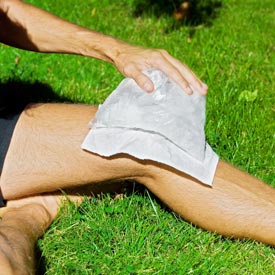Knees
For appointments please call 636-231-5881 or visit our online appointments page
Knee Injuries
Dr. Corey G. Solman, Jr. treats patients in the St. Louis area with a variety of knee problems including sports-related injuries, ACL problems, meniscus pain, fractures and arthritis.
Quadriceps Tendonitis
This condition results in pain localized right above the kneecap where the quadriceps tendon joins the patella.
Patellar Tendonitis
Pain localized to the front of the knee in the region of the patellar tendon. This is a condition typically occurring from repetitive running, jumping and impact activities.
Chondromalacia Patella
This condition can be very debilitating depending on the degree of degeneration or softening of the coating cartilage under the kneecap. The degenerative process may be a result of trauma, alignment of the kneecap, or repetitive stress.
Patellar Instability
This condition may begin as an acute dislocating patella episode which has the potential to lead to chronic knee pain and subsequent dislocation. Other underlying issues may be generalized ligament laxity, acute rupture of the medial patella femoral ligament, and poor patellofemoral alignment. Depending on the nature of the underlying problem may determine if surgical intervention is necessary.
Baker’s Cyst
This is a function of an individual that has an underlying arthritic condition. Individuals will complain of fullness in back of knee and inability to fully bend knee. The cyst is a fluid filled sac that will wax and wane in size depending on how symptomatic the arthritis is at that time.
Osgood-Schlatter
This condition is primarily an adolescent issue occurring during a rapid growth phase. The bones are growing faster than the soft tissue can accommodate resulting in pain localized to the front of the shin bone at the growth plate. This is primarily treated conservatively but at times surgical management is recommended.
Arthritis
This condition is a degenerative process of eroding the joint lining cartilage that covers the ends of femur and tibia. Depending on the progression of the arthritis determines conservative versus surgical management (Partial Knee Replacement, Patellofemoral Replacement, or Total Knee Replacement Surgery at our St. Louis clinic).
Cartilage Injuries
The following injuries can occur in all age groups:
Medial Meniscus Tear
This “shock absorber” is located on the inside portion of the knee between the femur and tibia. Depending on the location of the meniscus tear determines whether Dr. Corey G. Solman Jr. will repair it or have the insulting tear removed.
Lateral Meniscus Tear
This “shock absorber” is located on the outside portion of the knee between the femur and tibia. Depending on the location of the tear determines if it is repaired or the insulting tear is removed.
Bursitis
The following injuries can occur in all age groups.
Pes Anserine Bursitis
This condition is a localized bursa found on in the inside portion of the knee at the top of the tibia. The bursa may become inflamed and swell and give the sensation that the knee wants to buckle or give way. This can be common after knee surgery due the change in knee mechanics. On occasion if the conservative management does not resolve the pain, surgical excision of the bursa is an option.
Ligament Injuries
The following injuries can be isolated or occur at the same time:
Anterior Cruciate Ligament (ACL) Tear
This ligament prevents the tibia from shifting forward and giving the sensation of instability. A tear of the ACL typically occurs with a cut and pivot, deceleration, or contact type of injury. Based on the age and demand of the individual will determine if surgical intervention is necessary.
Medial Patella Ligament Disruption
This condition occurs in individuals either with generalized laxity or after and acute patella dislocation injury. This ligament is a check reign that prevents the patella from gliding laterally. Reconstruction of this ligament prevents future dislocations and preserves the coating cartilage of the patella.
Medial Collateral Ligament (MCL) Tear
This ligament is on the inside portion of the knee that connects the femur and tibia. The MCL has an adequate blood supply and often can heal conservatively.
Lateral Collateral (LCL) Tear
This ligament is on the outside of the knee and connects the femur and tibia. An injury to this ligament may require surgical reconstruction.
Posterior Cruciate Ligament (PCL) Tear
This ligament prevents the tibia from shifting backwards and creating instability.
Knee Trauma
Chronic Knee Pain
See a doctor immediately if you hit, strain or fall on your knee and experience any of the following symptoms:
See a doctor if you experience any of the following symptoms for longer than 3 weeks, and if these symptoms are not alleviated with R.I.C.E. (Rest, Ice, Compression, Elevation) and anti-inflammatory pain medication:

- Instability or Sensation Knee is Going to Buckle or Give Way
- Locking or Catching in the Knee
- Immediate Swelling
- Immediate Onset of Sharp Pain
- Bruising
- Inability to Bear Weight on Affected Leg
- Limited Motion of the Knee

- Stiffness
- Gradual Swelling
- Throbbing at Night
- Uncomfortable with Weather Changes
- Generalized Achiness
- Inability to Perform Normal Daily Activities
CONTACT US TO FIND OUT HOW WE CAN HELP
Corey G. Solman, Jr., MD is conveniently located in the St. Louis area and sees patients by appointment only during regular office hours.Office Phone: 636-231-5881
Office Fax: 636-735-8536
Office Address: 14825 North Outer Forty Road Suite 310, Chesterfield, Missouri 63017
Hours: Monday - Friday: 8AM - 5PM
